Praise for Braised Winter Melon
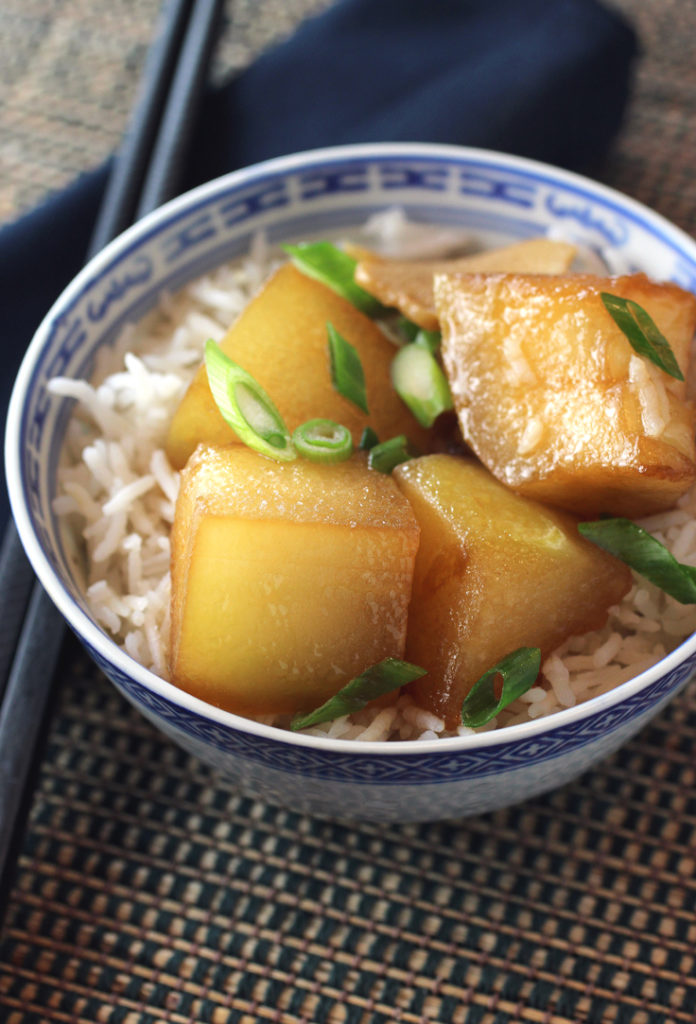
Some ingredients like caviar and truffles are unabashedly luxe.
Others like celery decidedly relegated — rightly or wrongly — to mundane.
Winter melon, though, is that rarity that falls equally into high- and low-brow camps.
Like tomatoes, these huge green-skinned melons, which can grow as large as 40 pounds, are actually a fruit that’s most often treated as a vegetable.
As a kid, I still have memories of many a Chinese restaurant Lunar New Year banquet at this time of year, where a waiter would gingerly carry a heaving half winter melon to the Lazy Susan on our table. Its skin would be intricately carved with Chinese characters for a grand presentation and its chasm filled to the brim with bubbling soup fortified with ginko nuts, shredded dried scallops, and the melon’s flesh. It was the epitome of special occasion.
In contrast, I also fondly remember my mom regularly making a much simpler version at home, cutting the melon into chunks to simmer in canned chicken broth with slivers of ginger, and sometimes a little bit of pork or chicken. It was not only an economical way to stretch a meal, but her way of trying to ward off colds and flus, as winter melon is high in Vitamin C.
Whether prepared fancifully or frugally, winter melon is a taste of home for me.
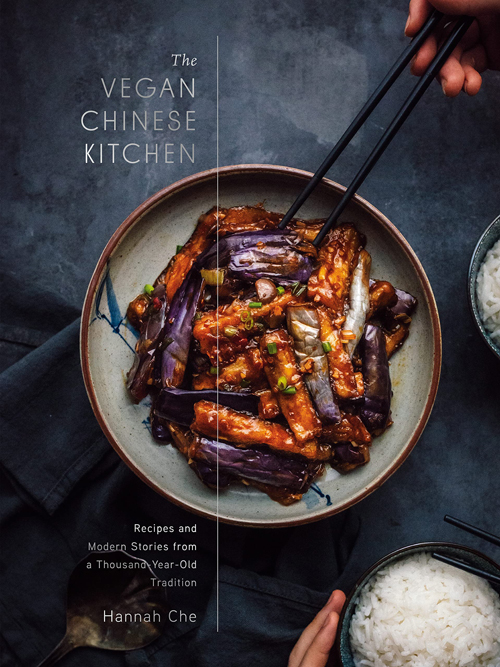
Even though it can be prepared many ways, including in candy and poached in a dessert soup, I’ve mostly had it in savory soups. That’s why this recipe for “Braised Winter Melon” immediately caught my eye as a novel method I just had to try.
It’s from “The Vegan Chinese Kitchen” (Clarkson Potter, 2022), of which I received a review copy. This collection of more than 100 plant-based Chinese recipes is by Hannah Che, a Portland, OR-based cook, writer and photographer who lived in China for several years and trained as a chef at the Guangzhou Vegetarian Culinary School.
Along with a primer on ingredients and equipment, the book is filled with evocative stories of Che’s time in China, meeting food artisans whose families have plied their skills for generations. The stories give deeper meaning to the recipes, and can’t help but entice you even more to try your hand at making everything from “Blanched Lettuce with Ginger Soy Sauce,” “Dry-Pot Cauliflower,” and “Stir-Fried Potato Threads with Fragrant Chiles,” to “Sweet & Sour Tofu,” “Five-Spice Vegetarian Chicken,” and “Eight Treasure Congee.”
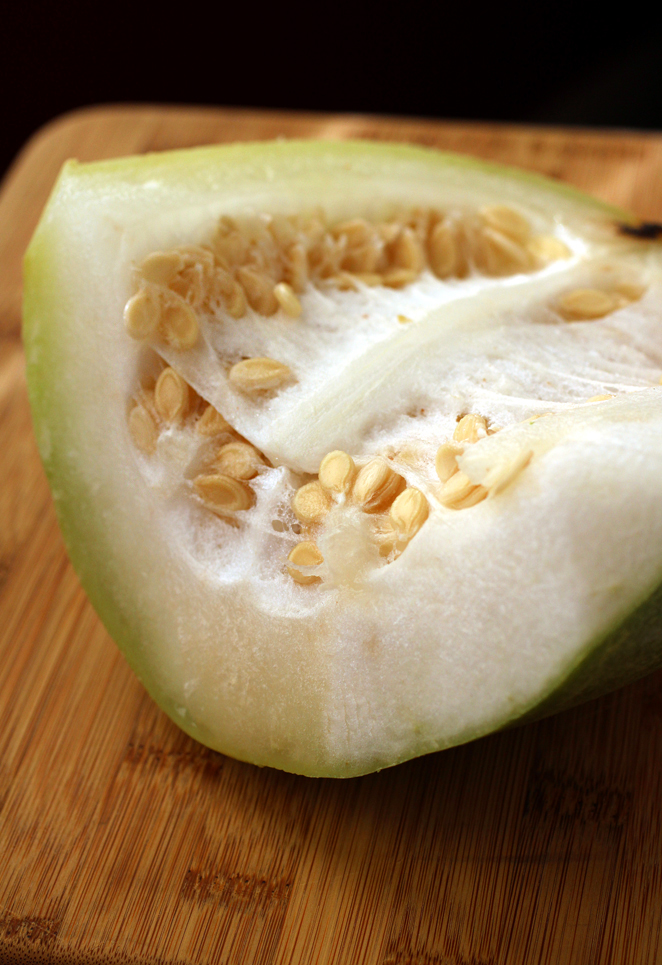
Although winter melon is grown during summer and autumn months, it stores for months, making it easy to find abundantly at this time of year at Asian markets or farmers’ market stands. Thankfully, given their girth, they are often sold cut in manageable wedges so you don’t have to lug home a whole one.
Simply remove the waxy skin, seeds and inner membrane before using. Its flesh is very much melon-like, watery and quenching. Its taste is very mild, kind of like a cucumber kissed by a subtle grassiness. But like tofu, it will easily absorb whatever sauces or seasonings you introduce.
This braised dish couldn’t be easier. It offers the option of using plain vegetable oil or of making your own scallion oil, which entails all of simmering sliced green onions in vegetable oil to infuse it, before straining. The scallions impart a sweet onion-y taste to the oil. I’ve included the full recipe for the scallion oil, though, I made only half of it, which ended up being just enough for this dish with a little extra to stir-fry some additional greens in for another side dish.
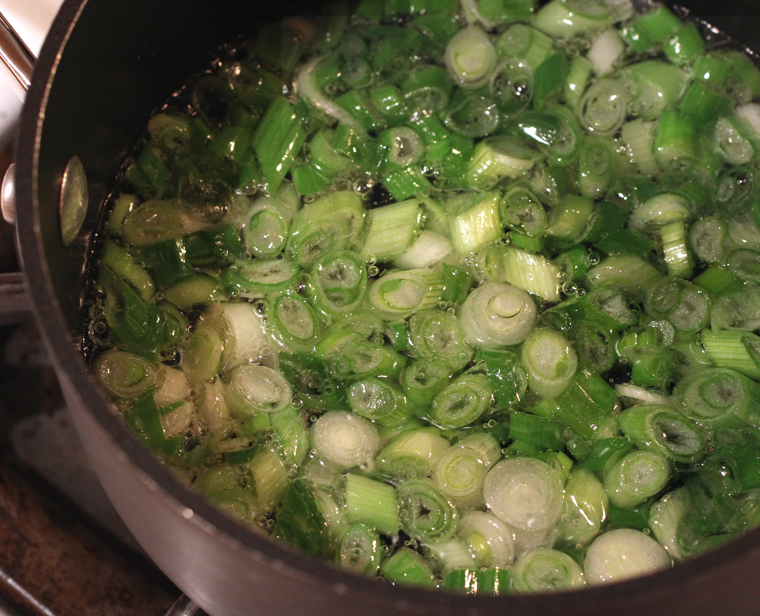
Chunks of winter melon get added to a hot wok with ginger, star anise, and bay leaves. Soy sauce, oyster sauce, sugar and vegetable stock go in next, and everything is allowed to simmer for a few minutes.
Before adding a starch slurry, which gives the broth a little gloss rather than thickens it significantly, you can add a dash more of dark soy sauce to give the dish a deeper color and bigger umami boost, which I recommend doing.
Spoon some atop a bowl of rice for a comforting meal. The winter melon, slippery soft and juicy, is still quite mellow tasting but heightened with the familiar warm combination of ginger and soy sauce.
No matter how you prepare it, winter was made for winter melon.
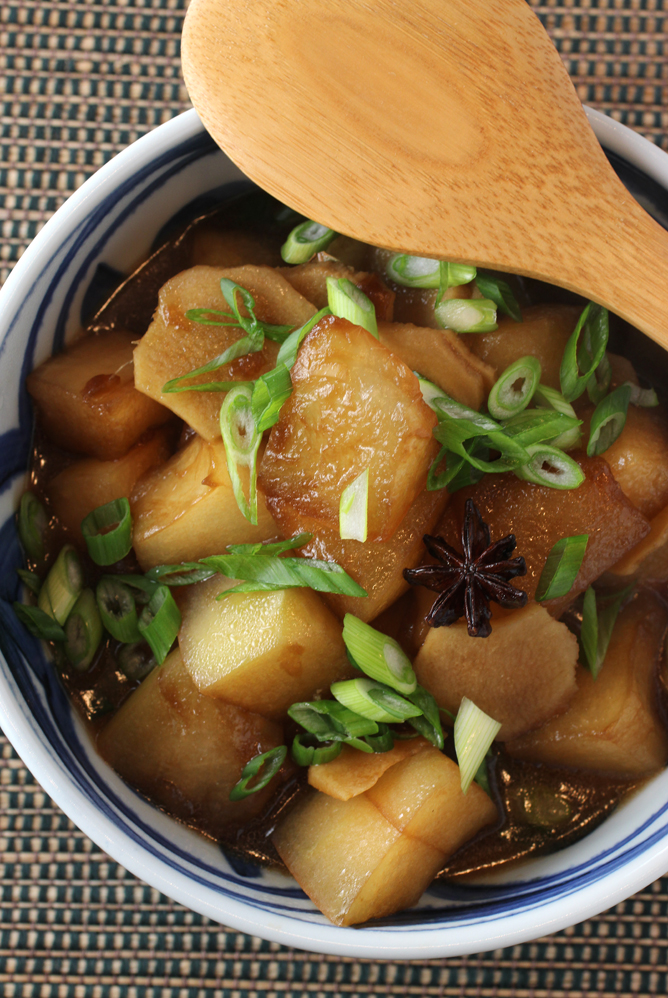
Braised Winter Melon
(Serves 4)
1 1/2 pounds winter melon
1/2 teaspoon dark soy sauce, plus more as needed
1/2 teaspoon potato starch or cornstarch
3 tablespoons Scallion Oil (see recipe below) or vegetable oil, divided
1 (2-inch) piece unpeeled fresh ginger, cut into thin slices
1 star anise pod
2 bay leaves
1 tablespoon soy sauce
1 teaspoon vegetarian oyster sauce
1 teaspoon sugar
1/2 cup unsalted stock of any kind or water
Kosher salt
1 scallion, green part only, thinly sliced, for garnish (optional)
With a sharp knife, trim the peel from the winter melon and cut out the frosty inner core and seeds. Cut it into chunks 1/2-inch thick and 1-inch wide, and toss with the dark soy sauce. Let sit for 10 minutes.
Combine the starch with 1 tablespoon cold water in a small bowl.
Heat 2 tablespoons of the scallion oil in a wok over medium heat until shimmering. Immediately reduce the heat to low, add the ginger, star anise, and bay leaves, and gently stir-fry until aromatic, about 3 minutes. Turn the heat to high, add the winter melon pieces, and stir-fry until the edges take on a translucent, softened quality and are beginning to caramelize on the wok’s surface, about 3 minutes.
Add the soy sauce, oyster sauce, sugar, and stock and bring to a boil. Cover, reduce the heat to maintain a simmer, and cook for 8 to 10 minutes more, until the winter melon is buttery and tender but still holds its shape. If you want, you can add a tiny amount of additional dark soy sauce (1/4 to 1 teaspoon) to deepen the color. Taste and season with salt as needed.
Finally, give the starch slurry a whisk and pour it into the wok, stirring continuously so that the liquid thickens into a glossy sauce. Transfer to a serving dish and scatter the scallion greens (if using) on top.
Scallion Oil
(Makes 1 cup)
12 scallions, rinsed and trimmed
1 cup vegetable oil or other neutral-flavored oil
Pat the scallions as dry as possible. Thinly slice them into circles or ovals.
Heat the oil in a wok or small saucepan over medium-high heat until shimmering. Add the scallions and stir them gently — the oil should be just hot enough that the scallions bubble gently along their edges. Cook the scallions over a steady low flame as they release their water and infuse the oil.
When the scallions are starting to darken and have a toasted aroma, 15 to 20 minutes, begin to stir continuously to help them develop an even golden color. Once they start turning brown and looking crispy, immediately remove the wok from the heat — overcooking will result in a burnt flavor.
Pour everything through a fine-mesh sieve set over a heatproof bowl and press the scallions with a spoon to squeeze out any remaining oil. The oil should be clear, with a slight greenish tinge. Discard the fried scallions — they should look pretty hammered if they’ve done their job properly — or reserve for one final use as a garnish for noodles.
Pour the strained oil into a lidded glass jar and store on the top shelf of your refrigerator for up to 2 weeks.
Adapted from “The Vegan Chinese Kitchen” by Hannah Che

More Dishes to Enjoy for the Lunar New Year: Oven-Steamed Fish
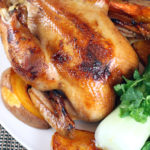
And: Roast Chicken with Ginger and Soy-Whiskey Glaze

And: Mama Chang’s Hot and Sour Soup

And: Soy Sauce Deviled Eggs with Five-Spice

And: Chinatown Ribs

And: Tea-Smoked Duck with Hoisin Barbecue Sauce

And: Almond Tofu with Fruit Cocktail

And: Quick Portuguese Custard Tarts

And: Almond Cookies

I’ve often seen winter melons being sold (in exactly the sort of sections you mentioned) but I never knew what to do with it and would always forget to look up options by the time I got home. I don’t love cucumber so I’m not sure how I’d feel about the taste of winter melon, but the recipe is definitely interesting to me and I’d like to give it a try sometime. I like getting to try new things, and this sounds cozy.
Hi K: I think you should give it a try. It’s not an expensive ingredient, so it’s easy enough to buy a cut chunk to see for yourself if it’s something you like without feeling like you’re wasting your money. Who knows? You might just find you love it, too. 😉
Hi K: I think you should give it a try. It’s not an expensive ingredient, so it’s easy enough to buy a cut chunk to see for yourself if it’s something you like without feeling like you’re wasting your money. Who knows? You might just find you love it, too. 😉